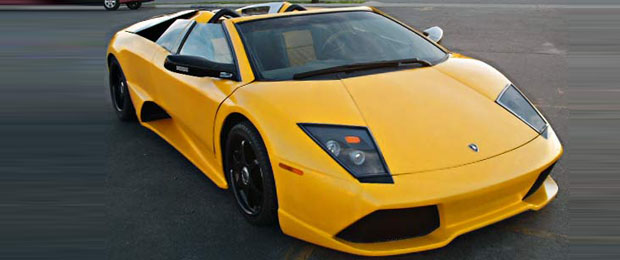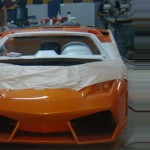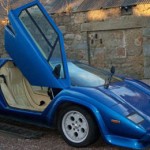By 2001, the Diablo, flagship of the Lamborghini line, was showing its age. Its lines were still nice but it had lost a lot of its cutting edge sharpness. It was also nearing the end of an 11-year run of success and it is still a sought-after vehicle on the auction circuit and sales of even 10-year-old Diablos that are at or well over their original near $200,000 purchase price are common. It’s the same for vehicle bearing the Lamborghini marque.
Murcielago kitcar by beyondcustom.com.au
What makes it interesting now is the Lambo is really part of Audi, although Sant’A Agata, in the Bolognese region is still the official manufacturing site. Audi wasn’t the owner, though, when, in 2001 the Lambo Mercielago debuted in 2001 as the Diablo’s replacement. On its debut, it drew quite a few reactions as no one had ever seen a vehicle that was designed like the Mercielago.
Lamborghini Murcielago LP640 Roadster Replica from Porsche Boxster
The feature that drew one’s attention to the Mercielago was its height — or more likely the lack of it. At its tallest point, the bullet-shaped road warrior is about 48 inches and yet, a six-footer could still unfold from one of the two seats when the either of the scissors doors rotated forward and opened revealing dual racing-style seats that were in a reclined racing position. The supportive racing-style seats (Recaro styling) had very little front-to-rear play, but they did and still do allow some impressive control for the driver and comfort, as well. The passenger’s seat is about what you’d expect in a high-performance vehicle. It’s comfortable, but it certainly isn’t in the class of a Bentley.
Toyota MR2 based Lamborghini Murcielago LP640
When the Mercielago appeared in 2001 its name continued a tradition established by none other than Ferruccio Lamborghini when he christened the Diablo. The Diablo took its name from a famed fighting bull of Spain. The heritage continued with the Mercielago. The Mercielago took its name from an incredibly strong and enduring bull that fought a matador to a draw just before 1880. The matador, the story goes, was so impressed by the bull and its tenacity as well as its standing up to nearly 30 blows that would have brought down other bulls, passed on the killing stroke and spared the Mercielago, as the bull was known. The old bull lived out a quiet life in pasture, it is believed.
The name connotes a fighting spirit and the Mercielago was all of that and more as it could run from 0 to 60 mph (almost 100 kph) in a little over 3 seconds from a standing start. This was in a vehicle equipped with a 3.5-liter V-12 (in the early years) that revved easily to 9,000 rpm and put out about 110 horsepower per liter. The design team claimed that with a little tweaking the same V-12 could do 400—horsepower at 11,000 rpm, but that idea was squelched.
Other Lamborghini Murcielago Replicas
All of this power, plus an all-wheel-drive system that not only helped to nail the Mercielago to the ground in turns and corners with great traction that features a mid-engine design that integrated the differential into the engine and used a viscous coupling to move power to the front wheels, was packed into an almost teardrop-shaped design that was smoothed and featured not only a electronically controlled spoiler for extra downforce at high speed (top end on the Mercielago was put around 205 mph) but also open two extra cooling ducts that rammed air into the mid-engine compartment. They were discretely placed high up in the rear sail panels.
The man responsible for this design is the famed Luc Donckerwolke, design chief at Lambo from 1998 to 2005, the Murcielago’s planning and first edition years.
The low-slung pocket rocket debuted with the Mercielago name. The name was also spruced up a bit with the addition of the letters VT after it, likely meaning veloce tourismo, or speedy coupe. The first model was available only as a coupe; however, about two years into its run a roadster joined the line so that there was now an open-air version of the Mercielago.
The first generation lasted until Audi bought up Lambo for a huge sum in 2006. After the sale, change became a way of life for the Mercielago as the LP640 appeared in coupe and roadster versions; the LP650-4 roadster appeared, a four-place open-air version that was superseded in the final run that ended just last year with the LP670-4 roadster.
Notice how the pace of change speeded up when Audi took over in 2006. That’s because the automaker was determined to challenge Ferrari for kingship of the road car world. The funny thing is that Audi had and still has the deep pockets to:
Shake things up and add to the line
Get more power to the wheels
Refine the design so that it is a smooth teardrop that cheats the wind
Lambo and then Lambo/Audi must have been doing something right because their sales continued briskly for a model whose building could be counted at fewer than 500 per year over its own 10-year career that ended in 2010.
During that time, the Audi engineering crowd, doubtlessly troubled by a V-12 that languished little changed since its introduction in 1963 wasn’t putting out the power Audi believed it should and the Audi folks upped the horsepower and size ante of the V-12, while retaining the same form factor. The V-12 60-degree V-12 (yes, it is a narrow V-engine, but it has to be so it can be mounted transversely in the midships of the Mercielago) now saw its size doubled to about 5.7-liters and nearly 600 horsepower.
The basic chassis and suspension layout remained the same as the Mercielago relied on a double independent wishbone suspension that controlled the body in turns and corners (the all-wheel-drive and ground effects downforce also helped) and enabled drivers to move through them as if the coupe or roadster was on rails. The transmission remained the same H-gated six-speed.
This was to prove a popular model as Lambo and Lambo/Audi turned out a total of 4,900 that, at between $200,000 and $250,000 a copy generated a lot of cash. Of course, each vehicle was incredibly labor-intensive as it was virtually built by hand from the frame up so they charged what they could and actually one-upped Ferrari with a double-overhead cam and four valves per cylinder, while Ferrari was still using a single overhead cam to do the same duty. That type of one-upmanship continues in the rarefied world of performance machines today.
It also exists in the kit car world where you have the likes Great Britain’s Extreme Kit Cars competing with Super Replicars (both have websites with their names in them) and while each is extolling the virtues of their models and how they are made, their replicars are not all that different.
The Mercielago lends itself more to the Toyota MR2 mid-engined chassis/frame because it is apparently lower than the Fiero.
Extreme Kit will sell you the entire kit, although you supply the frame/chassis, for about $12,468 and give you a detailed DVD with step by step instructions in how to build it. What they fail to tell you, though, is that you also have to invest the $7,000 or more for the frame/chassis in the first place. Then they fail to tell you that you have to invest another $2,400 in wheel spacers, plus $4,000 in the proper wheels and tires. T window regulators will cost you just short of $1,000 and a set of rear taillights will also set you back about another $1,000. Even a small item such as the grille is $233. This means, if you have the garage space to build, the tools to handle the parts and the skill to put it all on the frame/chassis that building one yourself will cost you about $30,000 to build one yourself. They will build you one for $35,000 which, granted, is far from the near $200,000 you will pay for the Mercielago or more, but which is still a lot of money for a vehicle that will be running about a two-liter Toyota four in place of the V-12 and will likely not have all-wheel-drive.
Of course, if you can scavenge a V-12 somewhere and you can shoehorn it into the MR-2 mid-engine space, you have the problem of shift and linkage and the like, so you will have to be content with what Toyota gives you.
Meantime, Super Replicars offers versions of the Mercielago kit from completely knocked down versions that you put together for about $20,000 (you still have to supply all the little things like the frame/chassis, wheels, glass and all that), and the expertise to put it together so the seams are close and straight and it doesn’t handle as if it were built by a group of Cub Scouts with their Dad’s toolkits. In other words, it doesn’t feel as if the front end and rear end are on different ends of the planet while you are trying to maneuver.
This may seem a harsh indictment, but if you don’t know how to do the work, don’t invest in a replicar or kit of this complexity to learn as you will end up with huge gaps in the seams. You will also have seams that may look as if they were hung by someone with a hangover.
Super Replicars also offers a full street performance-oriented version that they will build for about $75,000, but it is nicely done and is reported to handle well with more than a modicum of power coming out of turns and corners.
Since the Mercielago is so recently departed from the production scene there are plenty of kit car and replicar sites on the Web where you can find what you need. Just use a search engine and try to research each kit maker as thoroughly as possible by reading reviews and blog posts before you make your final decision.



































Leave a Reply
You must be logged in to post a comment.